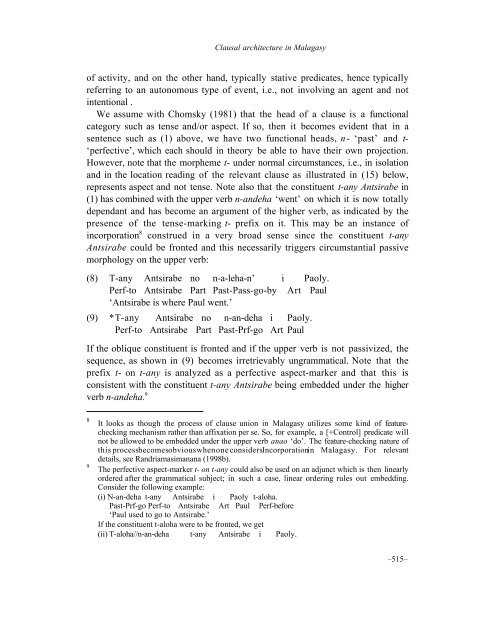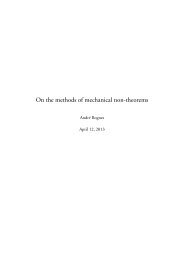Clausal architecture and movement verbs in Malagasy
Clausal architecture and movement verbs in Malagasy
Clausal architecture and movement verbs in Malagasy
Create successful ePaper yourself
Turn your PDF publications into a flip-book with our unique Google optimized e-Paper software.
<strong>Clausal</strong> <strong>architecture</strong> <strong>in</strong> <strong>Malagasy</strong><br />
of activity, <strong>and</strong> on the other h<strong>and</strong>, typically stative predicates, hence typically<br />
referr<strong>in</strong>g to an autonomous type of event, i.e., not <strong>in</strong>volv<strong>in</strong>g an agent <strong>and</strong> not<br />
<strong>in</strong>tentional .<br />
We assume with Chomsky (1981) that the head of a clause is a functional<br />
category such as tense <strong>and</strong>/or aspect. If so, then it becomes evident that <strong>in</strong> a<br />
sentence such as (1) above, we have two functional heads, n- ‘past’ <strong>and</strong> t-<br />
‘perfective’, which each should <strong>in</strong> theory be able to have their own projection.<br />
However, note that the morpheme t- under normal circumstances, i.e., <strong>in</strong> isolation<br />
<strong>and</strong> <strong>in</strong> the location read<strong>in</strong>g of the relevant clause as illustrated <strong>in</strong> (15) below,<br />
represents aspect <strong>and</strong> not tense. Note also that the constituent t-any Antsirabe <strong>in</strong><br />
(1) has comb<strong>in</strong>ed with the upper verb n-<strong>and</strong>eha ‘went’ on which it is now totally<br />
dependant <strong>and</strong> has become an argument of the higher verb, as <strong>in</strong>dicated by the<br />
presence of the tense-mark<strong>in</strong>g t- prefix on it. This may be an <strong>in</strong>stance of<br />
<strong>in</strong>corporation 8 construed <strong>in</strong> a very broad sense s<strong>in</strong>ce the constituent t-any<br />
Antsirabe could be fronted <strong>and</strong> this necessarily triggers circumstantial passive<br />
morphology on the upper verb:<br />
(8) T-any Antsirabe no n-a-leha-n’ i Paoly.<br />
Perf-to Antsirabe Part Past-Pass-go-by Art Paul<br />
‘Antsirabe is where Paul went.’<br />
(9) *T-any Antsirabe no n-an-deha i Paoly.<br />
Perf-to Antsirabe Part Past-Prf-go Art Paul<br />
If the oblique constituent is fronted <strong>and</strong> if the upper verb is not passivized, the<br />
sequence, as shown <strong>in</strong> (9) becomes irretrievably ungrammatical. Note that the<br />
prefix t- on t-any is analyzed as a perfective aspect-marker <strong>and</strong> that this is<br />
consistent with the constituent t-any Antsirabe be<strong>in</strong>g embedded under the higher<br />
verb n-<strong>and</strong>eha. 9<br />
8<br />
It looks as though the process of clause union <strong>in</strong> <strong>Malagasy</strong> utilizes some k<strong>in</strong>d of featurecheck<strong>in</strong>g<br />
mechanism rather than affixation per se. So, for example, a [+Control] predicate will<br />
not be allowed to be embedded under the upper verb anao ‘do’. The feature-check<strong>in</strong>g nature of<br />
this process becomes obvious when one considers Incorporation <strong>in</strong> <strong>Malagasy</strong>. For relevant<br />
details, see R<strong>and</strong>riamasimanana (1998b).<br />
9<br />
The perfective aspect-marker t- on t-any could also be used on an adjunct which is then l<strong>in</strong>early<br />
ordered after the grammatical subject; <strong>in</strong> such a case, l<strong>in</strong>ear order<strong>in</strong>g rules out embedd<strong>in</strong>g.<br />
Consider the follow<strong>in</strong>g example:<br />
(i) N-an-deha t-any Antsirabe i Paoly t-aloha.<br />
Past-Prf-go Perf-to Antsirabe Art Paul Perf-before<br />
‘Paul used to go to Antsirabe.’<br />
If the constituent t-aloha were to be fronted, we get<br />
(ii) T-aloha//n-an-deha t-any Antsirabe i Paoly.<br />
–515–

















